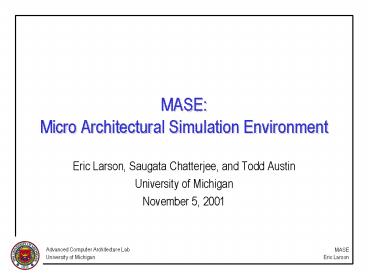MASE: Micro Architectural Simulation Environment PowerPoint PPT Presentation
Title: MASE: Micro Architectural Simulation Environment
1
MASEMicro Architectural Simulation Environment
- Eric Larson, Saugata Chatterjee, and Todd Austin
- University of Michigan
- November 5, 2001
2
MASE overview
- MASE is a new performance simulation
infrastructure for SimpleScalar. - Features and goals of MASE
- Checker improves validation support.
- Oracle allows for perfect studies.
- Micro-functional performance model increases
accuracy. - Speculative state management facilities simplify
aggressive speculation. - Callback interface permits sophisticated memory
system simulation. - A test release of MASE will be available in
December at www.simplescalar.com
3
SimpleScalar 3.0 software architecture
Functional Units
Reorder Buffer (ROB)
4
MASE software architecture
5
Checker and oracle
- Permit perfect studies and improved validation.
- Oracle executes in fetch and places values into
ISQ. - Checker uses ISQ values to validate core
computation. - Checker will fix any core bug, reducing burden of
correctness in core.
6
Micro-functional performance model
- Trace-driven techniques cannot accurately model
timing-dependent computation. - For example, mispeculation and shared memory race
conditions. - Instructions are now executed in the core with
proper timing. - Further improves validation, intertwining timing
and correctness.
7
Support for aggressive speculation
- SimpleScalar lacks arbitrary instruction restart.
Only branches can restart. - MASE allows any instruction to mispeculate and
restart core. - Several data structures (such as the ROB and ISQ)
were modified to support arbitrary rollback.
8
Memory system with callback interface
- SimpleScalars memory system requires that
instruction latency be known at issue. - Not representative of modern memory systems.
- For example, DRAM accesses can be reordered to
increase page hit rates. - Instructions use callback interface to
asynchronously declare their (remaining) latency.
9
Memory system with callback interface
10
Other improvements
- Algorithm for detecting when store data can be
forwarded to loads has been improved (more
aggressive). - Register update unit (RUU) has been split into a
reorder buffer (ROB) and reservation stations
(RS). - Added a scheduler queue.
- Scheduler predicts the latency of each
instruction. - Instructions are replayed if the prediction is
too small. - Added a front-end queue.
- Improves misprediction delay accuracy.
- Can simulate additional stages in the front-end
pipeline.
11
Early results and analyses
- Validated MASE against SimpleScalar 3.0
sim-outorder. - Less than 1 difference for SPEC95 integer
benchmarks. - MASE is half as fast as sim-outorder, but MASE is
unoptimized (future work). - Arbitrary speculation mechanism tested with blind
load speculation study. - Implementation was straight-forward in MASE.
- Checker simplified implementation of store
forwarding. - Partial store forwarding logic was not
implemented. - Relied on checker to detect and correct these
cases. - Minor inaccuracy, at most 195 errors (vortex).
- Checker proved to be a valuable debugging aid
when implementing other features of MASE.
12
Conclusion
- Checker supports validation by reducing the
burden of correctness on the core. - Micro-functional core allows for more accurate
modeling. - Speculative state management facilities simplify
implementations of aggressive speculation
techniques. - Memory system callback interface supports modern
memory systems. - A test release of MASE will be available in
December at www.simplescalar.com

